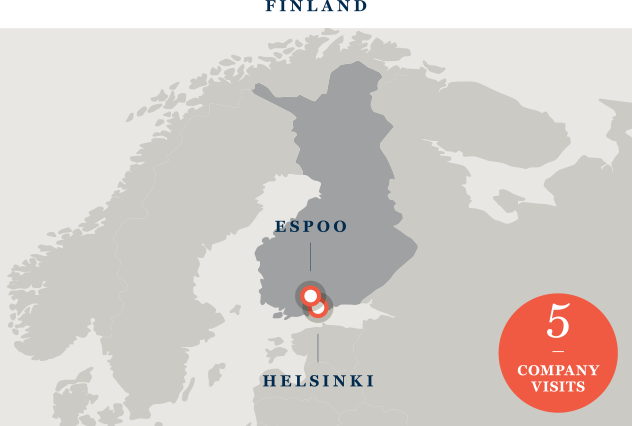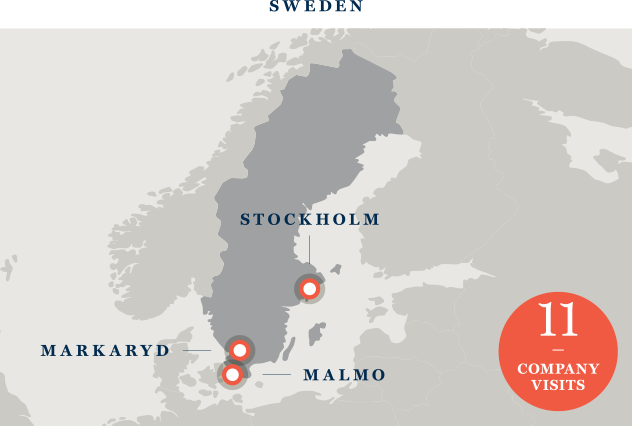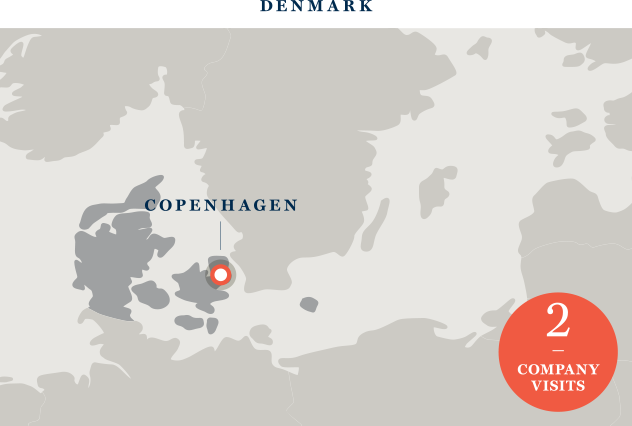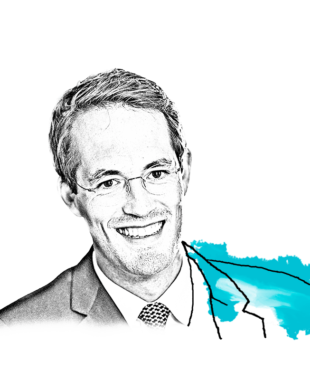The Nordic region has long punched above its weight on the world stage, producing innovative, dynamic companies with serious global ambitions. It’s also proved a fertile hunting ground for Walter Scott’s Research team over many decades. In November, investment managers Alex Torrens and Ashley-Jane Kyle spent nine days visiting companies and speaking to management teams in this hotbed of entrepreneurial endeavour.
Our previous extended research trip to the Nordics was in 2019, when two members of the Research team went in search of the secret to the region’s flair for innovation. Between 2005 and 2015, the Nordics created more than 50% of Europe’s billion-dollar start-up exits, earning itself the moniker ‘the unicorn factory’ in the process. All this with just 3% of the continent’s population.1
How to explain this disproportionate success? An established entrepreneurial culture with a long-term mindset and global focus certainly helps. So too, flexible labour markets alongside a generous but well-designed welfare system that provides a safety net for aspiring entrepreneurs. In the words of one Swedish business leader “if I could create this business in any country in the world, it would be here.”

Our trip began in Espoo, the second largest city in Finland and part of the Greater Helsinki metropolitan area. Given Finland shares both a land border and a somewhat fractious history with its much larger neighbour Russia, we arrived expecting the war in Ukraine to feature heavily in our discussions with management teams. In the event, whilst almost every company we met on our visit to the region spoke of being impacted to some extent, primarily through second-round effects like energy inflation, most were relatively sanguine. Those that had direct Russian exposure have already taken the necessary steps to close or write off their operations. Some, such as renewable fuel manufacturer Neste and heat-pump manufacturer NIBE (about both of whom more later) even spoke of experiencing increased demand since the onset of the conflict.
Indeed, reflecting the global profile of so many Nordic businesses, our discussions with elevator engineering firm KONE focused far more on developments in China than those taking shape across the Gulf of Finland. While KONE is a significant player in all the world’s major markets, it has a leading position in Asia Pacific and China. Recent lockdowns and real estate sector uncertainty in China have been unwelcome headwinds of late, so speaking with the CFO and other senior representatives at KONE’s headquarters was an opportunity to better understand how the company is dealing with these and other China-related issues.
Despite the current economic backdrop in China, major elements of KONE’s business are still performing well, most notably servicing and modernisation, and the adoption of digital services. Management has been flagging to investors for nearly a decade that new installations in China would eventually slow and that servicing and modernising the existing installed base would grow in importance. That’s proving to be the case, and momentum for now is extremely strong.
How best to respond to the geopolitical situation with Taiwan has also been high on management’s agenda in recent months. KONE’s focus has been on giving more accountability and autonomy to local management in China, a process that was already underway during the pandemic. The rationale for ‘localisation’ appears sound. As a business, KONE’s China operations are relatively self-sufficient, with positive cash flow, a high level of profitability and limited need for working capital. In these days of increased trade tensions, it’s also unlikely that KONE will be hit by any restrictive policies, given it doesn’t operate in an area deemed to be strategically important by the Chinese government.
Rounding off our time in Finland was a visit to Neste, a company that exemplifies the Nordic talent for innovation. Founded in 1948, Neste started life as an oil refiner, becoming Finland’s largest company in the 1970s. In the mid-1990s, however, the business patented refining technology that enabled fats and oils to be transformed into renewable fuel. Today, Neste is the world leader in renewable diesel and sustainable aviation fuel, with a 60% share of the global market. These are products aligned with several regulatory directives, including the US government’s Renewable Fuel Standard program and the EU’s Renewable Energy Directive, which should support robust growth in the coming years.
Technological innovation and access to feedstock will be crucial to capturing this opportunity and speaking with Neste it was clear that the business has distinct competitive advantages in both. Not only does the company have its differentiated NEXBTL technology, the patents for which are constantly being refreshed with the development of new varieties of feedstock, but its first-mover advantage has enabled it to secure access to feedstock networks across Europe, Asia, and the US. New market entrants will find these raw materials much harder and more expensive to access.

From Finland, we travelled to Sweden’s capital Stockholm before moving on to Markaryd and finally Malmö on the country’s southern tip. As in Finland, Swedish management teams learn early to look beyond their own borders in pursuit of larger global opportunities. As the CEO of Thule explained “our website was in 23 languages from an early stage”. Based in Malmö, Thule designs and manufactures transportation and outdoor activity related products – think roof racks and car boxes, and increasingly car seats and strollers too. Today, its core brand is sold in 140 markets across the world.
Having been primarily a sub-supplier to the automotive industry, Thule has evolved in recent years into more of a lifestyle brand, whilst staying laser-focused on the all-important functionality of its products. The business retains close links with automotive players, however, which allows for early insights into new models and forthcoming design changes. Indeed, the day before we met with the CEO, Volvo launched its new EX90 model. Thule knew about this vehicle years in advance and had spent that time designing complimentary products. The same goes for most of the luxury car brands – Maserati, Porsche, Land Rover and others all use Thule to design and manufacture their ownbrand racks and carriers.
Much useful information can be gleaned from annual reports and audited accounts, but they don’t tell the whole story.
Some 100 kilometres north of Malmö is the small town of Makaryd, population ~4,000, around a quarter of whom are employed by NIBE, a manufacturer of heat pumps, heating elements, and stoves. From its no-frills but rapidly expanding facilities, NIBE is tapping into the growing demand for more energy efficient heating solutions. Heat pumps capture heat from outside before transferring it into the home. Importantly, the quantity of heat delivered into the home is much greater than the quantity of electricity used to power the system. At least three times more efficient than traditional fossil fuel boilers, heat pumps will be critical to the global energy transition. Under the International Energy Agency’s Net Zero Emissions by 2050 Scenario, the number of heat pumps installed globally rises from 180 million in 2020 to 600 million in 2030.2
The technology for heat pumps has been around for decades, although for a long time its use was limited primarily to the Nordic countries. Widespread adoption in the region can be traced back to the 1970s, when the oil crisis prompted many households to replace their traditional oil boilers with heat pumps. In Sweden today, some 75% of family homes have a heat pump. Circumstances are now driving interest elsewhere, too. Regulatory incentives and growing consumer climate awareness are boosting demand at the same time as spiralling fossil fuel prices are making the economic rationale for heat pumps more compelling, particularly in Europe.

Our final stop was Denmark’s capital Copenhagen, where we met with an interesting IT consultancy founded and run by IT engineers, as well as the iconic Danish brewer Carlsberg, currently celebrating its 175th anniversary. Of all the companies we spoke with, Carlsberg has probably been most impacted by the conflict in Ukraine. Rising input costs are necessitating product price increases, whilst in March management took the decision to divest its Russian business Baltika, which at the time held approximately 27% market share and employed more than 8,000 people.3 More than 30 bids are currently under consideration. In a poignant reminder of the human element of this story, we were told that Carlsberg has 40 employees fighting on the front line for Ukraine and 50 that have been conscripted by Russia.
Only a couple of days after our return to Edinburgh, a visit to Walter Scott’s offices by Finnish telecom Nokia formed an interesting coda to our trip. A poster child for Nordic innovation in the 1990s and early 2000s, Nokia was the major player in the global cell phone market before a series of poor decisions culminated in the sale of its once mighty handset business to Microsoft. Various reasons have been posited for this relative decline, among them a dysfunctional internal culture, stifling bureaucracy, and executive hubris. Nokia’s is a cautionary tale and a timely reminder of why research trips are integral to our investment approach. Much useful information can be gleaned from annual reports and audited accounts, but they don’t tell the whole story. There are rich qualitative insights to be gained from visiting companies and speaking with management teams. Alarm bells often only ring when observing how a company and those tasked with its long-term direction operate on the ground.
Encouragingly, few red flags appeared on our Nordic trip. Management teams were typically very impressive, with a deep knowledge of their markets and a keen grasp of the opportunities open to them. As always, we left enthused by our conversations and our impressions of the region itself. There are few places globally that offer companies such favourable conditions in which to flourish, and for investors to unearth compelling investment opportunities.
Sources:
1Creandum Nordic Tech Exit Report, 2016
2IEA, September 2022
3Carlsberg
Stock Examples
The information provided in this video relating to stock examples should not be considered a recommendation to buy or sell any particular security. Any examples discussed are given in the context of the theme being explored.
Important Information
This video is provided for general information only and should not be construed as investment advice or a recommendation. This information does not represent and must not be construed as an offer or a solicitation of an offer to buy or sell securities, commodities and/or any other financial instruments or products. This video may not be used for the purpose of an offer or solicitation in any jurisdiction or in any circumstances in which such an offer or solicitation is unlawful or not authorised.



